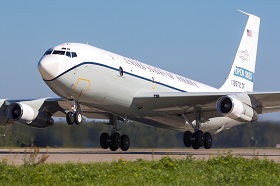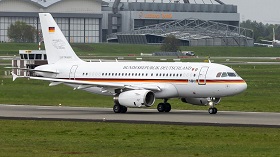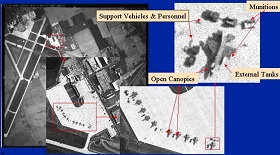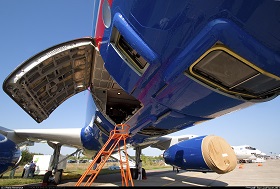If the U.S. does decide to withdraw from the Treaty on Open Skies, this will be quite ironic from the historical standpoint, since the Treaty is rooted in an idea initially proposed by an American president. During his election campaign, Dwight Eisenhower suggested mutual observation flights by the U.S. and the USSR, arguing that this could reduce the military tension between the two nations. After his election, the famed World War II commander did a lot to lower the degree of military threat. Real detente was still far away, but Eisenhower, at the very least, contributed to ending the war on the Korean Peninsula; he also put an end to the McCarthyism hysteria, albeit not immediately, and began building dialogue with the new Soviet leadership.
At the July 1955 summit in Geneva, Eisenhower invited the Soviet leaders to begin mutual observation flights as a way to reduce the threat of surprise attacks. Moscow did not reject the idea outright but preferred to bury it in debates and counter-proposals. The idea would be revisited in subsequent decades but never seemed to have any real chance of being implemented. Eisenhower later recalled that the Soviets had probably perceived the proposal as an attempt at barefaced espionage, despite his sincerely good intentions [1] (that said, the good intentions did not prevent Eisenhower from approving launch of U-2 reconnaissance flights over the Soviet Union, and his presidency marked the peak of U.S. aerial spying against the USSR).
The real reason the Soviet leadership declined the tempting opportunity of legitimately reconnoitring U.S. military facilities might have been that Moscow, back in those days, was desperately bluffing when it came to its nuclear and particularly nuclear-missile potential. Its actual ability to deliver a nuclear strike against the U.S. was nothing compared to its propaganda efforts [2]. Real military parity would not be achieved until a decade and a half later, at best, and Soviet authorities might have been justifiably worried that the Americans would decide to attack if they found out that the USSR only had a handful of nuclear weapons to respond.
The idea of the mid-1950s was only seriously revisited in the late 1980s, at the end of the Cold War, as the two countries were already on the peak of the disarmament process. U.S. President George Bush Sr floated the proposal in 1989, and the Soviet authorities of the time accepted it with enthusiasm, just as they had any initiatives related to international security. By then, the Open Skies system had already been pioneered with a multilateral treaty ensuring mutual trust between NATO and the Warsaw Pact. The first mutual proof-of-concept observation flights were conducted by Hungary and Canada in January 1990 [3].
The Treaty on Open Skies was signed in Helsinki on March 24, 1992, by 27 countries. Its ratification and enactment took quite a long time. Russia did not ratify it until May 26 2001; the Treaty came into force in 2002, after which observation flights began. More than 1,500 such flights have been performed to date [4].
Legitimate Overflights
Most of the 100-page Treaty details the requirements on what is diplomatically referred to as observation flights and observation equipment. Profound transparency is vital: any facilities, even the most sensitive ones, are to be open to observation. For example, during the first U.S. tour of the new Russian Tupolev Tu-214ON observation aircraft in April 2019, it overflew training centres of the THAAD missile defence system, the White Sands Missile Range (one of the primary U.S. testing sites), facilities of the Sandia and Los Alamos National Laboratories (which produce components for nuclear and hypersonic weapons), Pueblo Chemical Agent-Destruction Pilot Plant, and even the Cheyenne Mountain Complex. This is not to mention numerous airfields and military bases of secondary importance along its flight path.
The only restriction applies to the distances covered by flights originating from the airfield designated by the observed side (aircraft arrive and depart with their mission equipment closed, any observation flights must originate from a designated airfield, and all such flights must have local representatives onboard). Still, these distances are generous enough for an observation flight to reach any facility of interest. Of more relevance to the observed country, because it allows for hiding a classified prototype at the last moment, is the requirement for the observation side to notify the observed party three days before its mission arrives and to file its flight plan one day in advance. Such preliminary notifications are also needed so that organizational issues might be ironed out, including any possible adjustments to local air traffic to prioritize the observation flight.
The number of flights that can be carried out per year is also limited: there are so-called passive quotas (how many third-country flights must be accommodated) and active quotas (how many flights may be performed, and where). Active quotas are allocated annually. Listing all the quotas for all the participating countries and analyzing how the passive and active quotas are interdependent would take up too much space in the article and distract the reader's attention (mainly because, in practice, these quotas do not work precisely as prescribed, since NATO countries virtually do not subject one another to observation flights). The only thing worth mentioning is this: Russia holds the biggest quotas and performs more flights than the other signatories to the Treaty, but it also hosts the biggest number of reciprocal flights. Russia is interested in all the NATO member states and they, in turn (except for rare exceptions), are exclusively interested in Russia. This results in more than double the number of U.S. flights conducted over Russia than of Russian overflights over the U.S.
The Treaty permits a fairly broad range of so-called observation equipment that may be used during the overflights:
- optical panoramic and framing cameras with a ground resolution of no higher than 30 cm at the minimum height above ground level, continuous of the ground up to 50 km each side of the flight path;
- video cameras with a ground resolution of no higher than 30 cm at the minimum height above ground level, provide a picture in real-time and are used during the flight to control other equipment;
- infra-red line-scanning devices with a ground resolution of no higher than 50 cm at the minimum height above ground;
- sideways-looking aperture radars with a ground resolution of no more than 3 m, over a swath no more than 25 km wide.
The kit mentioned above is inaccessible to most of the signatory countries, as only one aircraft type carries the entire set of equipment cleared by the Treaty. Most other aircraft make do with optical photographic cameras, including ones using photographic film. Many signatory countries have no observation aircraft of their own at all; they are permitted to operate joint flights with the countries that do have such assets. All data collected during an observation flight is to be submitted to a database accessible to all parties to the Treaty.
How high is the quality of the data obtained by sensors on observation aircraft? Quite naturally, that is frequently compared to the quality of data collected by spy satellites, which, thanks to Hollywood movies, are believed by ordinary people to be capable of getting quality images of human faces and discerning vehicle number plates or even reading newspaper text.
The classified nature of the topic certainly jogs people’s imagination but, judging by indirect indications, the best spy satellites out there operating in ideal conditions produce imagery slightly better than 20 cm per pixel; 10 cm per pixel is the atmospheric limit of aerial observations (angled shots reduce quality further). Commercial satellite photography services provide a resolution of no more than 50 cm per pixel. Contemporary digital algorithms allow for improving and "completing" the image, but no computer can "reinvent" a newspaper text. Therefore airborne cameras are still better than satellite-based assets simply because they have to negotiate a much thinner atmospheric level and are much closer to the ground (for example, the Google Earth service uses aerial photography with a resolution of some 15 cm for the best quality shots).
The 30-cm quality limit for the Treaty on Open Skies remains within limits offered by commercial off-the-shelf and exclusive spy photography equipment (in fact, back in the day when that limit was decided, there were no contemporary commercial services available), and it is quite possible that it was chosen precisely with this consideration in mind. Since the U.S. is most unwilling to share intelligence even with its closest allies, especially in raw-data format, it is little wonder that Treaty on Open Skies is a valuable source of information for the other NATO member states and a useful resource for Russia, which does not have a significant reconnaissance satellite constellation of its own.
Cause or Motive?
Considering that the Treaty is so useful, why is the current U.S. administration (if we are to believe the leaks) planning to withdraw from it and why is this intention being backed by U.S. politicians and experts? Apart from formal complaints about Russia's observance of the Treaty, there are also the actual hidden causes.
Ever since the Treaty was enacted and particularly in recent years, its implementation has periodically run into problems. Since these problems have mostly been to do with overflights over Russia, Washington has had certain questions for Moscow. Some of the incidents have been well reported. For example, in 2002–2016, Russia would restrict observation flights, citing security concerns. Airspace over Chechnya would be closed down at some point; in 2008, overflights were similarly banned over Russian regions bordering on Georgia, and an observation flight over the area in which Exercise West was held in 2013 was not approved. Some bans have been rather technical, which is why they weren't reported, such as the altitude restrictions over Moscow and airspace closures over airbases on public holidays. Washington's significant complaints have to do with the additional unilateral limit on the flight length over the Kaliningrad Region (not more than 500 km) and the disputes over flights along the border with Abkhazia and South Ossetia.
The latter topic directly follows from the two territories’ partially recognized status as independent nations. Since Russia acknowledges them as such, Treaty on Open Skies mandates [6] that it prevent observation flights over its territory that come closer than 10 km to the territory of any country that is not a party to the Treaty. Georgia and the countries of the west that support its position and view the entire stretch of the Russian Transcaucasia border from the Black Sea to the border with Azerbaijan as a border with a Treaty on Open Skies signatory country. Georgia has been declining Russian observation flights since 2012. The crisis exacerbated in late 2017 when Georgia’s position prevented active quotas from being adopted for the following years, so no observation flights were conducted in 2018.
In a spirit of goodwill and driven by its desire to preserve the Treaty on Open Skies, in 2018 Russia said it would permit observation flights close to the border with Abkhazia and South Ossetia, provided that Georgia upheld its obligations. This move allowed for keeping the Treaty and approving the 2019 quotas, so observation flights resumed. Yet Georgia proved uncooperative, so the planned joint US-Swedish-German flight in the area was denied. Given the further worsening of Russo-Georgian relations in 2019, the conflict is still ongoing.
The U.S. is particularly unhappy with Russia’s restrictions on observation flights over the Kaliningrad Region. Just like in the case with Abkhazia and South Ossetia, the Kaliningrad problem stems from the very text of Treaty on Open Skies, which does not provide for the existence of small exclaves. As a result, while following the original text of the Treaty as applied to the maximum flight range and observation flight priority over civil air traffic, foreign observers (whether owing to their interest in local military facilities or just being in the mood for some hooliganism) could paralyze all commercial traffic over the Kaliningrad Region.
In 2014, one such incident, which involved a Polish aircraft, prompted Russia to restrict the length of observation flights over the exclave territory to 500 km. Moscow argues that the restricted range was more than enough as it allowed nearly the entire territory of the Kaliningrad Region (which is about 200 km long) to be covered. The U.S. says the unilateral restriction is illegitimate and continues to ignore Russia’s explanations. U.S. publications state that the Kaliningrad restrictions constitute just further proof of the threat to the Baltic States posed by the Region, which is allegedly stuffed with private military facilities. Such statements are addressed to audiences whose geographical knowledge leaves much to be desired. In this light, slogans along the lines of "the Russians only allowing 500-km flight distances instead of the prescribed 5,500 km" appear quite convincing. In response, the U.S. has restricted flights over Hawaii and banned the use of several airfields.
Certification of Russia’s new Tu-214ON observation aircraft long remained a subject of dispute. The no-equivalents phrase as applied to Russian equipment is so hackneyed it is nowadays only perceived as being ironic. Yet in this particular case, it is spot-on. Whereas the other parties to the Treaty on Open Skies only operate cameras (often cameras using film, including ones operated by the U.S.) installed on ageing converted transport or passenger aircraft, Russia has built two dedicated full-capacity aircraft fitted with all the sensors permitted by the Treaty. This fact, by the way, indicates Moscow's sincere interest in keeping the Treaty on Open Skies. The two aircraft are also actively used in military exercises and, according to some sources, have been used in Syria.
Ironically, this superb capability of the sensor-equipped aircraft resulted in a prolonged certification process. The airframes were delivered to the Russian Aerospace Forces in 2013 and 2014. Still, they were not certified until the autumn of 2018, primarily owing to the position of the U.S., which was the last party to sign the certification documents. Nonetheless, some U.S. complaints were to the point. For example, the original sensor equipment on the Russian aircraft included photographic cameras producing imagery of better quality than permitted by the Treaty. Russia argued that this would present no problem thanks to automatic software-enabled noise contamination. Still, the Americans can be forgiven for apparently suspecting that the imagery obtained would be de-contaminated once the aircraft returned to Russia. Eventually, the cameras were replaced by simpler (but similarly digital) designs that had been previously certified and used by Russia on an Antonov An-30 observation aircraft overflying Eastern Europe.
At some point, the Tu-214ON certification came to present such a bone of contention that U.S. Congress blocked the aircraft's use in the 2019 national defence act [7]. Yet U.S. forces in favour of preserving Treaty on Open Skies managed to convince the national administration, pretty much at the very last moment, that the aircraft needed to be cleared. With just one week to go until the beginning of the current financial year, on September 24, 2018, the U.S. became the last Treaty on Open Skies signatory state to certify the type, which began observation flights in 2019.
Back then, the feeling was that, against the doom and gloom in other aspects of US-Russian relations, the two countries were demonstrating a high level of common sense and readiness to compromise on Treaty on Open Skies. One party was prepared to overlook the sensitive issue of non-recognized territories for the sake of preserving the Treaty, while the other was making last-minute interventions in the decisions of its legislature. Even so, whether as a result of steps taken by John Bolton, the launch of the U.S. election race or just President Donald Trump's weather-vane policy, it appears that Washington has already decided to pull out from the Treaty.
The actual reasoning behind this decision is evident. The U.S., with the world's biggest constellation of reconnaissance satellites and nearly daily manned and unmanned reconnaissance flights close to Russia's borders, obtains very little new data from Open Skies flights. The Treaty is undoubtedly useful for the U.S.'s allies and the general international security architecture, but these aspects appear to be of little concern to the current U.S. administration.
Not Great Not Terrible
Russia appears to be sincerely interested in preserving the Treaty on Open Skies, which it seems to find useful. This is evident by the money Moscow spends on creating missionized aircraft, by intensive observation activities (compared to those of many other parties to the Treaty, which never use up their quotas), and by its readiness to compromise even in the face of seemingly principled positions. Russia is using the Treaty not only as a way to collect intelligence, but also to demonstrate its transparency. In particular, nearly 20 observation flights have been performed near the Russian-Ukrainian border since the beginning of the conflict, none of which have revealed any indications of aggression. Unlike U.S. "secret satellite imagery", which is never to be made publicly available "for considerations of national security”, Russia cleared these flights while being fully aware that, owing to the nature of the Treaty, any data thus collected could be made public.
Russia will most likely be unable to influence the U.S.'s position. It has previously been stonewalled on even more critical issues, such as the INF Treaty so, and if the U.S. administration has already made a decision, the matter is as good as done. An active dialogue with European nations to prompt them to pressure the U.S. in a coordinated effort might bring some results. The Washington proponents of Treaty on Open Skies primarily argue that the Treaty is essential to America's allies and that the U.S.'s egotistic unilateral withdrawal could provoke an adverse reaction.
On the other hand, if the U.S. pulls out, Russia will be left to decide, pretty much on its own, whether Treaty on Open Skies should be kept at all. If Moscow chooses to withdraw as well, the Treaty will be buried immediately. Such a decision would be simple, understandable and emotionally tempting. The alternative would be to preserve the Treaty on Open Skies as a confidence-building measure for the sake of the European nations. This choice would require a certain will and readiness to be subjected to attacks by domestic hawks and jingoists. It will also require Europe’s ability to think independently rather than blindly siding with Washington.
This alternative is much more difficult but potentially more profitable because it would contribute to European security while drawing a clear dividing line between the actors supporting arms control and those preferring to put themselves outside the tried-and-tested confidence-building mechanisms. The very existence of a security accord exclusively between Russia and Europe might lay the foundations for initiatives such as a regional moratorium on the deployment of medium-range missiles.
Russia would not lose much from a U.S. pullout from Treaty on Open Skies. U.S. territory would become unavailable for observation flights. However, there would still be Europe, including the military sites currently being deployed by the U.S., which are of greater concern to Moscow and raise its understandable interest. NATO, for its part, would find itself less capable of conducting observation flights without the U.S., since American observation aircraft fly over Russia twice as frequently as Russian aircraft over the U.S.
We are left to observe the situation and wait for Washington to take whatever next step it decides on. If that step is taken towards burying Treaty on Open Skies, all we can do is hope that the Russian reaction will be calculated appropriately.
1. “Back to the Future and Up to the Sky: Legal Implications of ‘Open Skies’ Inspection for Arms Control”, PDF, стр. 427
2. The panic and fear, apparently fed by the scaremongering U.S. defence industry, that Soviet Russia was hiding, somewhere in the vistas of its territory, legions of combat-ready strategic bombers (and later ICBMs) aimed against America persist and are known as the bomber gap and missile gap.
3. Given these two countries' contribution to the signing of the Treaty on Open Skies, they were identified as treaty depositaries. Should the U.S. decide to pull out of Treaty on Open Skies, it will be obligated to one or both depositaries, which, in turn, will have to convene a conference of the other signatories to decide on the future course of action.
4. “The Treaty on Open Skies: Background and Issues”, Congressional Research Service, IN10502, Updated October 11, 2019
5. There are, however, satellites capable of better quality. For example, Digital Globe’s WorldView-3 sensor is advertised as being capable of producing imagery of down to 31 cm per pixel.
6. P 2, Section II, Article VI
7. Notably, Congress has repeatedly denied Pentagon's requests for very modest sums to be spent on upgrading the U.S. observation aircraft with at least digital cameras. The 2020 budget request, which has not been approved yet, calls for the allocation of a budget for developing a new observation aircraft.








